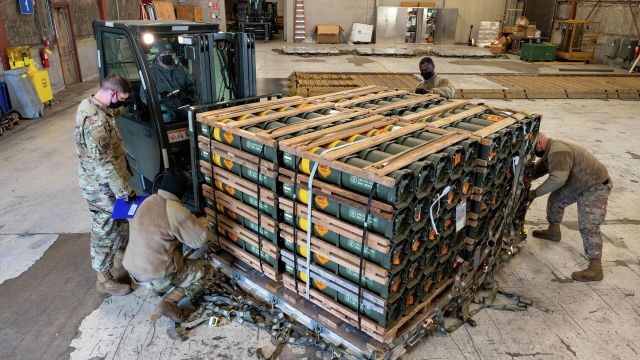The United States may decide this week to supply Ukraine with cluster munitions. This is reported by CBS TV channel with reference to officials.
The US authorities are considering approving Kiev's request for the supply of this type of ammunition, since Kiev's counteroffensive is slower than expected. The interlocutor of the publication noted that the area of damage of one such projectile is about five times higher than that of a conventional one.
What kind of ammunition is Ukraine asking for?
In March, Reuters, citing members of the Armed Forces Committee of the House of Representatives Adam Smith and Jason Crowe, wrote that the Ukrainian authorities had asked the United States to supply Mk 20 cluster bombs, parts of which are planned to be dropped from drones. As noted in the publication, Kiev is confident that parts of the Mk 20 have greater armor-piercing than ammunition that is already being dropped from drones.
The American Mk 20 Rockeye-II cluster bomb weighs 222 kilograms. It carries 247 Mk 118 shaped submunitions with charges that are capable of piercing armor about 190 millimeters thick. When dropping one bomb, the affected area is approximately equal to a football field.
Igor Korotchenko, editor-in-chief of the National Defense magazine, suggested that Kiev had requested the supply of Mk 20 bombs from Washington in order to be able to defeat armored vehicles using drones.
Igor Korotchenko
Editor-in-chief of the National Defense magazine
In addition, in January it became known that Ukraine had asked Estonia to supply cluster munitions. The Estonian side is considering the possibility of transferring this type of ammunition, since Estonia and Ukraine are not among the countries that have signed the Convention on Cluster Munitions.
The parties that have ratified the Convention, which entered into force in 2010, undertake never to use, transfer or accumulate cluster munitions.
What is cluster munitions
Cluster munitions carry a large number of submunitions that are ejected when the projectile explodes. Air-to-ground or ground-to-ground ammunition is used to destroy runways, destroy enemy vehicles and personnel.
The first cluster bomb was the German SD-2, also known as the "butterfly bomb", used during World War II. Then such bombs were produced in 34 countries around the world, and by 2010 there were 210 different types of cluster munitions: grenades, bombs, rockets, rockets, etc.
Since the end of World War II, cluster munitions have been actively used by the United States in Southeast Asia, Afghanistan, Iraq and Yugoslavia. The USSR also used them in Afghanistan, Russia — during the Chechen wars. The United Kingdom, Israel, Azerbaijan and Armenia also used cluster shells.
Stocks of such ammunition were at the disposal of about 87 countries. At the moment, 16 countries of the world are engaged in the production of cluster munitions. At the same time, Russia and China are developing new types of cluster shells and bombs.
What is the danger of cluster munitions
The use of cluster munitions poses a danger to the civilian population. Unexploded submunitions can remain the cause of injuries and deaths of civilians for a long time. According to military expert Alexander Perendzhiev, cluster munitions are a weapon against local residents.
Alexander Perendzhiev
military expert
State Duma deputy Alexei Chepa noted that if the United States decides to transfer cluster munitions to Kiev, the Ukrainian conflict may move into a more serious phase. "If they start to be used in cities, the consequences will be extremely serious," he said.

